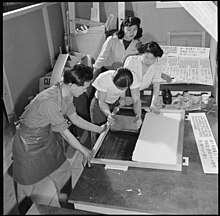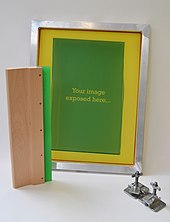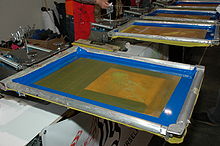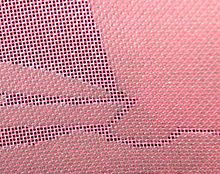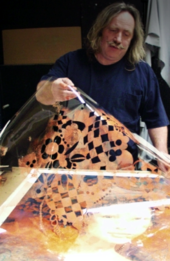Screen printing
This causes the ink to wet the substrate and be pulled out of the mesh apertures as the screen springs back after the blade has passed.
Advanced uses include laying down conductors and resistors in multi-layer circuits using thin ceramic layers as the substrate.
Roy Beck, Charles Peter and Edward Owens studied and experimented with chromic acid salt sensitized emulsions for photo-reactive stencils.
there are large selections of pre-sensitized and "user mixed" sensitized emulsion chemicals for creating photo-reactive stencils.
[3] "Serigraphy" is a compound word formed from Latin "sēricum" (silk) and Greek "graphein" (to write or draw).
Guido Lengweiler has corrected this misunderstanding in his book, A History of Screen Printing, published in English in 2016.
Outgrowths of these WPA poster shops, at least two New York City studios in wartime started decorating ceramic tiles with fire-on underglaze applied by silkscreen starting as early as 1939: Esteban Soriano and Harold Ambellan's workshop called Designed Tiles.
Since rudimentary screenprinting materials are so affordable and readily available, it has been used frequently in underground settings and subcultures, and the non-professional look of such DIY culture screenprints have become a significant cultural aesthetic seen on movie posters, record album covers, flyers, shirts, commercial fonts in advertising, in artwork and elsewhere.
Warhol was supported in his production by master screen printer Michel Caza, a founding member of Fespa.
American entrepreneur, artist and inventor Michael Vasilantone started to use, develop, and sell a rotatable multicolour garment screen printing machine in 1960.
The frame which holds the mesh could be made of diverse materials, such as wood, metal, or aluminum, depending on the sophistication of the machine or the artisan procedure.
A stencil is formed by blocking off parts of the screen in the negative image of the design to be printed; that is, the open spaces are where the ink will appear on the substrate.
Once this emulsion has dried, it is selectively exposed to ultra-violet light, through a film printed with the required design.
They are then washed away using a water spray, leaving behind a clean area in the mesh with the identical shape as the desired image, which will allow passage of ink.
Different inks can be used to work with a variety of materials, such as textiles, ceramics,[13] wood, paper, glass, metal, and plastic.
Whilst manual screen printing can be done with carousels, handbenches (both of which are often referred to colloquially as presses) or even on to tables.
[18] These machines are much faster and use either pneumatic pressure generated by air compressors or use electric motors to draw the squeegees, rotate and raise or lower pallets removing much of the manual labour from the task and use UV for instant image curing - resulting in significant reductions in operator fatigue as well as more consistent results.
[20] Typical names for these service print overlays include tSilk/bSilk aka PLC/PLS[21][nb 1] or TSK/BSK (EAGLE), F.SilkS/B.SilkS (KiCad), PosiTop/PosiBot (TARGET), silkTop/silkBottom (Fritzing), SST/SSB (OrCAD), ST.PHO/SB.PHO (PADS), SEVS/SERS (WEdirekt)[22] or GTO/GBO (Gerber and many others[23]).
Its versatility and ability to deposit thick layers of inks make it ideal for creating conductive tracks, sensors, and other electronic components.
Furthermore, screen printing offers advantages such as high throughput, low production costs, and compatibility with a wide range of substrates, including flexible materials.
Fine-line resolution, compatibility with advanced materials, and the need for precise registration pose ongoing research and development opportunities.
However, continuous advancements in ink formulations, equipment, and process optimization are paving the way for exciting future possibilities, including the integration of printed electronics into Internet of Things (IoT) devices, energy harvesting systems, and more.

